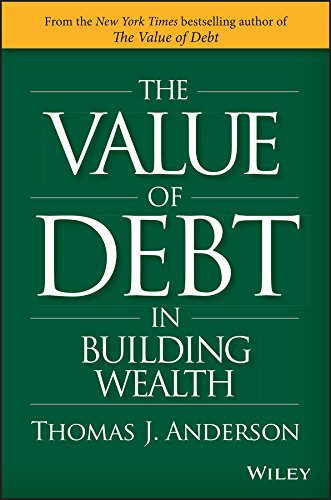In The Value of Debt in Building Wealth, bestselling author Thomas J. Anderson writes about strategically using debt to build wealth in the long run. Anderson notes that Debt is a powerful tool that corporate financial officers have understood since capitalism was born. Savvy use of debt provides liquidity and flexibility, allowing smart companies to jump on opportunities and ride out emergencies.
Debt is neither good nor bad. It is simply a magnifier. If you choose investments that deliver higher returns than the after-tax cost of your debt, then debt adds value. If you choose investments that return less than the after-tax cost of your debt, then debt destroys value.
“The single biggest determining factor in your rate of return and in being on track for retirement is your debt, debt structure, and the choices you make with respect to debt. Do not underestimate the power of building up assets early and paying down debt later.”
Glide Path
Glide paths are traditionally buoy lanes for ships and runway lights for airplanes. They are crucial for success and survivability. If captains and pilots don’t stay within their confines, they could crash. Glide paths set a course and provide necessary boundaries.
Traditional Glide Path
In the traditional financial glide path, debt adds no value. It should be eliminated as fast as possible. Doing so is financially responsible, will increase security, save money,reduce stress, and put you on a better path to financial freedom.
Debt Leverage
Almost all successful companies use debt as a tool to provide liquidity and a cushion for emergencies and opportunities, but very few individuals and families are even willing to think about this strategy. Individuals and families tend to either have too much debt or want to pay off all of their debt as soon as they can.
L.I.F.E. Framework
- Launch. When your net worth is low and/or you are truly just getting started
- Independence. When you have accumulated a small nest egg
- Freedom. When you have a medium nest egg
- Equilibrium: When you have a large nest egg, are living a balanced life, and are preparing to retire
Types of Debt
Amortizing debt
Amortizing debt is debt that is paid off with a fixed payment schedule over a period of time.
Oppressive Debt
Anything with a rate higher than inflation plus 6 percent to be oppressive debt—the trans-fat of debt. In the United States in late 2016, this would be any debt that has an interest expense over approximately 8 percent and certainly anything with a rate over 10 percent. If you have this type of debt, pay it off.
Working Debt
If you have a mortgage, student loan, or small business loan, you are using working debt. Generally, this is debt tied to a specific purpose and has a lower rate—typically under inflation plus 6 percent and ideally closer to inflation on an after-tax basis.
Enriching Debt
Enriching debt is debt that you choose to have yet could pay off at any time. It’s at a very low interest rate, perhaps close to the rate of inflation, and you also have the money in the bank to pay it off. This type of debt may allow you to capture the spread, meaning over time you may have the opportunity to make more money on an investment than it costs to borrow the money.
“Interest rates, on their own, are neither good nor bad. They are a function of the economy at any given time.”
The four phases of your financial L.I.F.E
- Launch
In this phase, you are just starting to build your wealth with an emphasis on reducing oppressive debt and building up a savings reserve. Your net worth is less than 50 percent of your gross annual pretax income (if your income varies, use the most conservative estimate).
“Launch: Net worth is less than 50 percent of gross annual pretax income”
2. Independence
You have a small nest egg and many people consider buying a home or taking on some working debt. Your net worth is between 50 percent and two times your gross annual pretax income.
“Independence: Net worth is between 50 percent and two times your gross annual pretax income”
3. Freedom
Your net worth is between two and five times your gross annual pretax income. You are at the point where you can safely and confidently take advantage of the debt strategies and reap the benefits of your financial decisions.
“Freedom: Net worth is between two and five times your gross annual pretax income.”
4. Equillibrum
Equilibrium. Your net worth is greater than five times your gross annual pretax income. You have a healthy, accessible cushion of cash in reserve. You are saving and enjoying life. You’re likely on track to retire with a comfortable amount of money to cover your expenses and enjoy life.
“Equilibrium: Net worth is greater than five times your gross annual pretax income”
Total debt includes
Face value of all mortgages, loans, debts. This includes student debt, credit card debt, debt to family members or friends, payday loans, and home equity lines of credit. It is everything you owe everybody.
Tax obligations due in the next 24 months that have not been reserved or withheld
Current value of future tax obligations that you believe should be included
Current value of all contractual obligations that cannot be completely covered by income (lease payments, long-term rentals)
Total assets – Total debts = Net worth
Phase 1: Launch
When your net worth is less than 50 percent of your gross annual income, you want to take as many steps as possible to avoid taking on any new debt.
Step 0: No oppressive debt.
Eliminate all credit card debt and/or debt with an interest rate higher than 10 percent. As money comes in, pay down debt and don’t add to your debt.
Step 1: Build a cash reserve equal to one month’s income.
When you’re living paycheck to paycheck, it’s easy to get caught up in payday loans and other oppressive debt. You need a reserve in your checking account. If you have oppressive debt and zero balance in your checking account, you are running your life on fumes. Bankruptcy—or worse, your survivability—could be on the line.
Step 2: Introduce retirement savings.
Because of the power of compounding interest, you want to build a retirement base as early as you can. Target a level equal to one-month’s income. Ideally this is in a tax-deferred plan such as an IRA or a company-sponsored retirement plan like a 401(k).
Step 3: Grow your cash reserve.
The goal is to add two additional months of cash reserve, so you have three months of liquid, accessible cash for emergencies.
“Until your net worth is more than 50 percent of your annual income, I strongly advise you to wait to buy a house or make any major purchases.”
Phase 2: Independence
In the Independence phase your net worth is more than 50 percent of your annual income and less than two times your gross annual pretax income.
Step 0: Zero oppressive debt.
Step 1: Build a three-month cash reserve in your checking account.
Three months’ reserve in a checking account is a good level of “oil in the engine” to cover surprise expenses.”
Step 2: Build your retirement savings. Work towards saving six times your monthly income.
Step 3: Establish a big life changes fund.
Savings vs Investing
- When you save, you set aside money for a specific goal within a specific time period.
- When you invest, you have longer-term objectives and may or may not need the money along the way. It might be for retirement or for some unforeseen event 10 years from now. You need to put your money into different accounts based on your needs.
“If you need it in less than 5 years, put it all into savings. If you need it in more than 10 years, invest it.”
Phase 3: Freedom
When your net worth is less than five times your annual income, you simply do not have enough money to retire. During this phase, you want to reduce your debt ratio, save toward retirement, and enjoy life.
“Do not pay down your debt during the Freedom phase; build up your savings.”
Phase 4: Equilibrium
In the Equilibrium phase, your assets are greater than five times your gross annual pretax income. At this point, your biggest debt is still the debt to your future self. You need to build up assets. We continue building up assets more than focusing on paying down debt.
“Your asset allocation and debt strategy will drive your net worth.”
All the best in your quest to get better. Don’t Settle: Live with Passion.



Comments are closed.